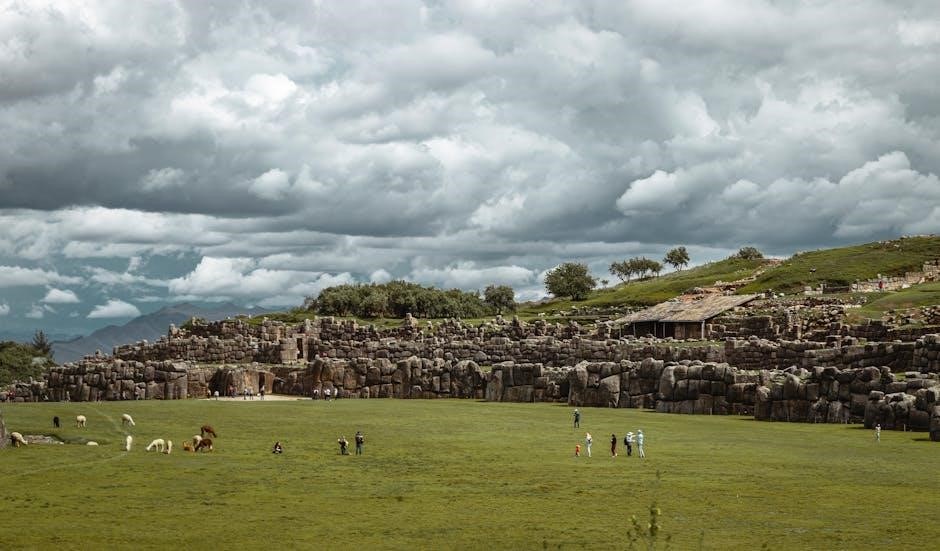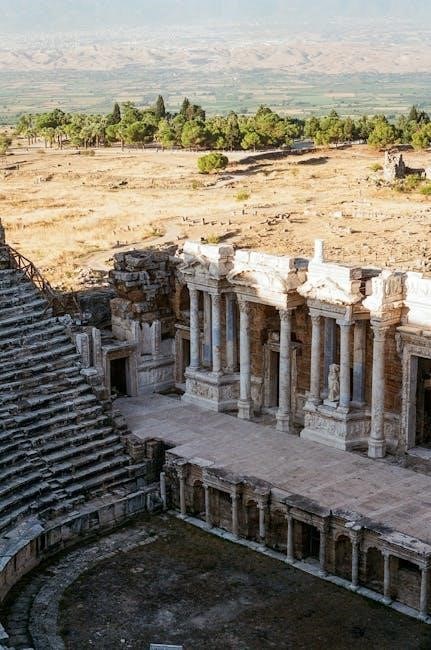The AP World History Exam assesses understanding of global historical developments, regional interactions, and thematic approaches. It offers resources like course descriptions, practice exams, and essay examples to prepare students effectively.
Overview of the Exam Format
The AP World History Exam includes multiple-choice questions, short-answer questions, essays, and a Document-Based Question (DBQ). The exam is divided into two sections: a 55-minute multiple-choice and short-answer segment and a 180-minute free-response section. Students are assessed on their ability to analyze historical events, themes, and processes across various time periods and regions. The format emphasizes critical thinking, evidence-based writing, and the ability to connect historical developments globally. Practice exams and course descriptions provide detailed insights into the exam structure and content expectations.
Importance of the AP World History Exam
The AP World History Exam is crucial for students seeking college credit and advanced placement. It fosters critical thinking, analytical writing, and historical reasoning skills. By mastering global processes and interconnections, students gain a deeper understanding of historical events and their relevance to contemporary issues. High scores on the exam demonstrate academic rigor and prepare students for college-level coursework. Additionally, it encourages a broader perspective on cultural, social, and political developments, enriching students’ intellectual growth and future academic pursuits.

Structure of the AP World History Exam
The exam includes multiple sections: multiple-choice questions, short answer questions, essays, and a Document-Based Question (DBQ), each with specific time allocations for completion.
Multiple-Choice Questions
The multiple-choice section of the AP World History Exam consists of 55 questions, each with four possible answers. These questions assess knowledge of historical events, themes, and processes across various time periods and regions. They often require the application of historical thinking skills, such as causation, comparison, and context. Test-takers have 55 minutes to complete this section, making time management essential. Strategies include eliminating incorrect answers and making educated guesses when unsure. Practice with sample questions helps improve speed and accuracy.
Short Answer Questions
The short answer questions (SAQs) section includes 4-5 prompts, requiring concise, well-structured responses. Students have 40 minutes to complete this part. Each question focuses on specific historical examples, themes, or processes, often requiring the application of historical reasoning skills. Answers should be clear and directly address the question, with relevant evidence and examples. Practice in writing focused, evidence-based responses is crucial for success in this section.
Essay Questions
The essay questions section of the AP World History exam requires students to develop and support a historical argument. Each essay prompt asks students to analyze historical developments, compare societies, or evaluate processes across different regions and time periods. Clear thesis statements, relevant evidence, and analytical explanations are essential. Students have 40 minutes per essay and must address all parts of the question. Practice in constructing well-organized, evidence-based essays is key to success in this challenging section.
Document-Based Questions (DBQ)
The Document-Based Questions (DBQ) section of the AP World History exam requires students to analyze and synthesize historical evidence from provided sources. Each DBQ includes 6-7 primary or secondary sources, and students must craft a coherent essay addressing the question. The essays are graded on thesis development, contextualization, evidence usage, and analytical depth. Students have 60 minutes to complete this section, making time management and careful planning essential. Practicing past DBQs is crucial to understanding the format and expectations.

Course and Exam Content
The AP World History course spans 8000 BCE to the present, emphasizing regional interactions, global processes, and thematic approaches. Key themes include environment, culture, and political systems, preparing students to analyze historical developments and global patterns across regions and time periods.

Key Historical Periods Covered
The AP World History exam covers six key historical periods, from 8000 BCE to the present. Period 1 (8000 BCE–600 CE) explores early civilizations and empires. Period 2 (600–1450 CE) focuses on religious and cultural exchanges. Period 3 (1450–1750 CE) highlights global interactions and empires. Period 4 (1750–1900 CE) examines industrialization and global conflict. Period 5 (1900–1945 CE) addresses war and political ideologies. Period 6 (1945–present) covers modern globalization and its challenges. Each period emphasizes themes like environment, culture, and power dynamics.
Regional Interactions and Global Processes
The AP World History exam emphasizes regional interactions and global processes that shaped human societies. It focuses on patterns of trade, cultural exchange, migration, and diplomacy across regions. Key examples include the Silk Road, the Columbian Exchange, and the spread of religions like Buddhism and Islam. These interactions highlight how regional developments influenced global systems, fostering interconnectedness and driving historical change. Understanding these processes is crucial for analyzing the complexities of global history and its ongoing impact on modern societies.
Thematic Approaches to World History
AP World History emphasizes thematic approaches to understand global patterns and connections. Themes like environment, economies, cultures, politics, and social structures provide frameworks for analyzing historical developments. These themes highlight how societies have interacted and evolved over time, addressing issues like technological progress, imperial systems, and social hierarchies. By focusing on these themes, students can better understand the complexities of global history and apply them to various historical periods and regions, preparing effectively for the exam.

Study Materials and Resources
Official study guides, online platforms, and practice exams provide essential preparation tools. Utilize resources like Khan Academy, Coursera, and digital flashcards for comprehensive exam readiness.
Official AP World History Course and Exam Description
The Official AP World History Course and Exam Description guide provides a detailed framework for the course and exam. It outlines the key concepts, historical periods, and skills emphasized in the curriculum. This document also includes sample exam questions and scoring guidelines, helping students and teachers understand the expectations. Available on the College Board website, it is a foundational resource for aligning studies with the exam format. Use it to identify focus areas and plan your preparation effectively.
AP World History Practice Exams
AP World History practice exams are essential for effective preparation. They simulate the actual test format, including multiple-choice questions, short answers, essays, and DBQs. These resources help students familiarize themselves with the exam structure, timing, and content. Practice exams are available on the College Board website and other educational platforms. By taking these exams, students can identify strengths, address weaknesses, and refine their test-taking strategies. Regular practice builds confidence and improves performance under timed conditions.
Recommended Textbooks and Online Resources
Several textbooks and online resources are highly recommended for preparing for the AP World History Exam. Textbooks like A History of the World in 1000 Objects and World History: Patterns of Interaction provide comprehensive coverage of key themes and periods. Online resources such as the College Board’s official materials, Khan Academy, and YouTube channels like Crash Course offer interactive lessons and study guides. Additionally, the AP World History Exam PDF guide is an invaluable resource for understanding exam structure and content.

Preparation Strategies
Effective preparation for the AP World History Exam involves creating a study plan, utilizing practice exams, and engaging in active learning techniques to master historical content.
General Study Tips and Time Management
Develop a structured study schedule, balancing review of historical periods and thematic concepts. Use active recall and spaced repetition to retain information effectively. Allocate specific time blocks for different topics, ensuring coverage of all periods and regions. Prioritize areas of weakness and practice applying historical thinking skills. Maintain organization by categorizing notes thematically and chronologically. Stay focused during study sessions by minimizing distractions and using time-management tools like timers. Regular breaks can enhance productivity and prevent burnout. Consistency and discipline are key to mastering the exam material.
Strategies for Tackling Different Question Types
For multiple-choice questions, skim the question and answer choices first, then read the stem carefully. Use the process of elimination to narrow down options. For short answers, focus on clear, concise responses with specific examples. Essays require a strong thesis and structured analysis, while DBQs demand integration of provided documents with prior knowledge. Practice pacing for each section to ensure adequate time per question. Reviewing question types and their requirements beforehand helps build confidence and efficiency during the exam.
Importance of Practice Exams
Practice exams are essential for mastering the AP World History exam format and content. They simulate real test conditions, helping students assess their readiness and identify areas needing improvement. Regular practice builds familiarity with question types, such as DBQs and essays, while refining time management skills. Additionally, practice exams reveal knowledge gaps, allowing focused study on weaknesses. They also reduce test-day anxiety by acquainting students with the exam’s structure and pacing. Regular practice is key to achieving a high score.

Scoring and Grading
The AP World History exam is scored on a 1-5 scale, with 5 being the highest. Scoring is based on performance across all sections, including multiple-choice, short answers, essays, and the DBQ. The College Board determines score cutoffs annually, ensuring fairness and consistency. Understanding the scoring system helps students interpret their results and identify strengths and areas for improvement; A score of 3 or higher is generally considered a passing grade.
Understanding the Scoring System
The AP World History exam scoring system ranges from 1 to 5, with 5 being the highest. The total score is derived from performance across multiple sections: multiple-choice, short answers, essays, and the DBQ. Each section is weighted differently, and raw scores are scaled to ensure fairness. The College Board determines the cutoffs for each score annually. A score of 3 or higher is typically considered passing and may qualify students for college credit or advanced placement. Understanding this system helps students interpret their performance accurately.
Interpreting Exam Results
AP World History exam results provide a detailed breakdown of performance across sections. Scores range from 1 to 5, with 5 indicating exceptional mastery. A score of 3 or higher is generally considered passing and may earn college credit. Results highlight strengths and areas for improvement, helping students gauge their understanding of historical periods, themes, and skills. Analyzing these results can guide future study habits and preparation for similar assessments. They also offer insights into readiness for advanced coursework.
Benefits of Taking the Exam
Taking the AP World History exam offers numerous benefits. It provides potential college credit, reducing future coursework. High scores enhance college applications, demonstrating academic rigor. The exam also fosters critical thinking, analytical skills, and historical understanding. Additionally, it prepares students for advanced coursework and future academic challenges. Earning a qualifying score can save time and money in college. Overall, the exam is a valuable opportunity to showcase knowledge and skills while opening doors to academic and professional growth.

Past Exam Examples and Analysis
Analyzing past AP World History exams provides insights into question patterns and content focus. Previous exams reveal common themes, such as cultural interactions and historical causation. Reviewing these examples helps students understand the exam format and identify areas for improvement. Historical data also highlights recurring topics, enabling targeted study strategies. Utilizing past exams as study tools enhances familiarity with question types and improves test-taking skills. These resources are invaluable for effective preparation and understanding the exam’s structure and expectations.
Previous Years’ Exam Questions
Previous years’ AP World History exam questions are invaluable study resources. They provide direct insights into exam formats, question types, and content emphasis. Official practice exams and past papers, often available as PDFs, allow students to familiarize themselves with the structure and timing. Analyzing these questions helps identify recurring themes, such as cultural interactions or historical causation. Additionally, these materials enable students to practice time management and refine their test-taking strategies. Utilizing past exams is a proven way to build confidence and improve performance.
Common Themes in Past Exams
Analysis of past AP World History exams reveals recurring themes, such as cultural interactions, imperial systems, and comparative analysis. Topics like trade networks, religious influences, and technological diffusion frequently appear. Environmental impacts and social hierarchies are also emphasized. Understanding these common themes helps students focus their studying on high-yield topics. By recognizing these patterns, test-takers can better anticipate question formats and content, ultimately improving their performance on the exam.
Lessons Learned from Historical Exam Data
Historical exam data highlights the importance of understanding key patterns and trends. Students often struggle with comparative analysis and chronological reasoning. High-scoring essays frequently address explicit comparisons and evidence-based arguments. Additionally, time management issues are common, particularly in the DBQ section. Analyzing past exams reveals that focusing on thematic continuity and global processes yields better results. Prioritizing these areas can significantly improve performance and alignment with the exam’s expectations.

Time Management and Test-Taking Tips
Allocate time wisely across sections to avoid rushing. Prioritize questions you’re confident in first. Skim questions to manage time effectively and avoid procrastination during the exam.
Allocating Time to Each Section

Allocate 40 minutes to multiple-choice questions, ensuring 30-45 seconds per question. Dedicate 40 minutes to short answers, spending 8-10 minutes each. For essays and DBQs, spend 35-40 minutes total, with 10-15 minutes per essay. Prioritize questions based on confidence and skip complex ones initially. Review remaining questions after completing easier ones. Use buffer time wisely to avoid rushing. Skim questions first to identify easier ones and plan your approach accordingly.
Strategies for Maximizing Score
To maximize your score, focus on answering all multiple-choice questions, as there’s no penalty for guessing. Use the process of elimination to increase chances of correct answers. For essays and DBQs, address every part of the question and use specific, relevant examples. Practice writing clear, concise thesis statements and ensure timelines are accurate. Reviewing past exams helps identify common themes and improves familiarity with question formats. Stay calm and systematic to optimize performance across all sections.
Common Mistakes to Avoid
Avoid rushing through questions without reading them carefully, as misinterpretation can lead to incorrect answers. Don’t neglect the Document-Based Question (DBQ) instructions, as failing to address all parts can significantly lower your score. Overpracticing one section while ignoring others creates imbalance. Procrastination in studying key themes and periods is a common pitfall. Lastly, ensure adequate sleep and nutrition before the exam to maintain focus and clarity. Addressing these errors can significantly improve your performance.
Final Thoughts on Preparing for the Exam
Preparation for the AP World History Exam is a journey requiring consistent effort and smart strategies. Leveraging resources like the AP World History Exam PDF can provide valuable insights and practice opportunities. Focus on understanding key themes, historical periods, and question formats. Time management and targeted studying are crucial. Stay confident, organized, and committed to your goals. With dedication and the right tools, you can approach the exam with confidence and achieve success.
Encouragement for Future Test-Takers
Embarking on the AP World History Exam is a commendable step toward academic growth. Embrace the challenge as an opportunity to deepen your understanding of global history and develop critical thinking skills. Utilize resources like the AP World History Exam PDF to familiarize yourself with the format and content. Stay motivated, and remember that consistent effort leads to success. Believe in your abilities, and approach the exam with confidence and determination. Your hard work will pay off!
Additional Resources for Continued Success
To further enhance your preparation, explore supplementary materials like online courses, study guides, and historical databases. The AP World History Exam PDF is an invaluable resource, offering insights into exam formats and content. Additionally, utilize digital platforms for interactive learning and join study groups for collaborative revision. Regularly review historical timelines and thematic concepts to reinforce your understanding. By diversifying your study resources, you can approach the exam with confidence and a well-rounded knowledge base.
